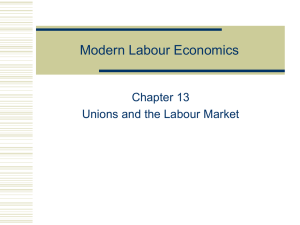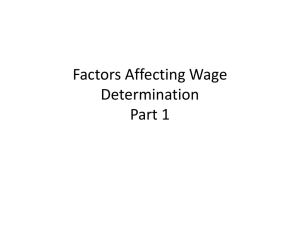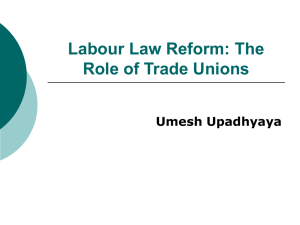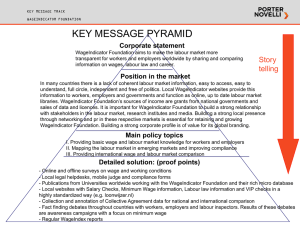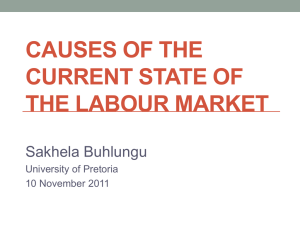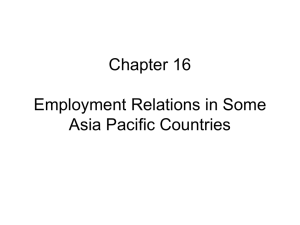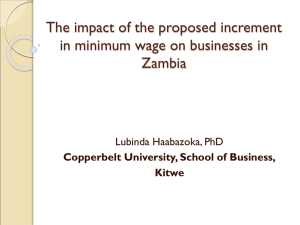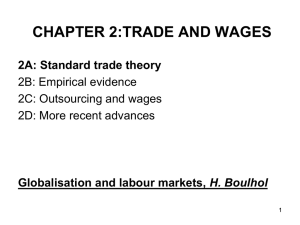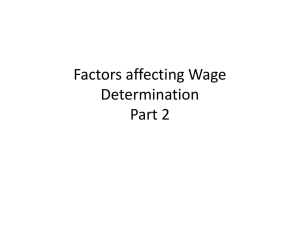Chapter 8: Wages, Rent, Profit, and Interest
advertisement
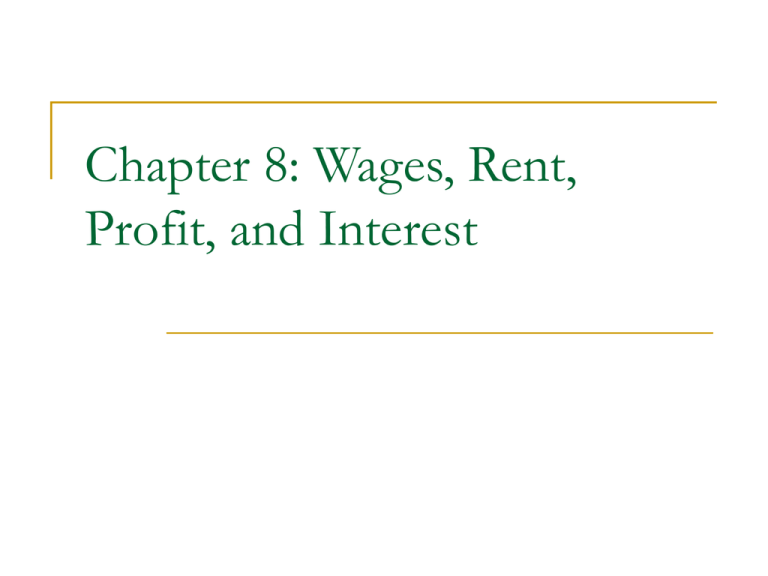
Chapter 8: Wages, Rent, Profit, and Interest Chapter Focus: The factors that affect wages, including productivity, education, experience, job conditions, regional disparities, market power, and discrimination The types, structure, collective bargaining practices, and impact of labour unions in Canada Rent, the market for land, the equilibrium value of land rent, and changes in demand for land Profit, and the functions it serves Interest, how it’s determined, the market for loanable funds, how the forces of demand and supply affect loanable funds, and the factors that determine the interest rate for an individual loan Wages: Wage: generally to include salaries and other forms of payment of labour Wage Determinants: Labour productivity: It determines the wage of workers. The output of each worker varies because of such factors as the worker’s ability to do the job, the use of complementary resources, and the state of technology Education: It has impact on labour demand and supply. Work that required jobrelated training tends to have a higher MRP. Human Capital: the income-earning potential of a person’s skills and knowledge Experience: it can increase productivity, pushing up the demand for the worker’s labour and the wage rate. Higher Exp, higher wage Seniority Right: the workplace privileges provided to workers who have the longest experience with their employer Job conditions: for less appealing occupations, employers offer higher wages Regional disparities: Market power: Labour Unions: workers’ organizations that negotiate with employers about wages, working conditions, and job benefits Discrimination: Job Discrimination: hiring, wage, and promotion decisions based on criteria other than a worker’s credentials or performance. Ex: gender, race, age, physical ability Job Segregation: the discriminatory division of occupation Labour Unions: Industrial union: a labour union of workers in a certain industry, no matter what their occupations Craft union: a labour union of workers in a particular occupation The Structure of Labour Unions: 1. Union Locals: Unionized workers in a certain factory, company, or geographical area Closed shop: a specific labour market in which all workers covered by a collective agreement must be union members Union shop: a specific labour market in which all workers covered by a collective agreement must become union members after a certain period of employment Open shop: a specific labour market in which union membership is not compulsory 2. National and International Unions 3. Federations and Congresses Collective Bargaining: Collective Bargaining: The process of union representatives negotiating with employers over workers’ wages, hours, and working conditions Mediation: The process of having an outside party determine and propose a settlement to employers and unions Arbitration: The process of having an outside party determine and dictate a settlement to employers and unions Working to rule: The union tactic of members slowing down working by adhering strictly to their job descriptions Strike: The union tactic of members ceasing to work Picketing: The practice of striking workers taking positions around the outside of the workplace, usually with signs, to publicize their cause to others Lockout: The employer tactic of barring workers from the workplace Profit: Profit: A positive economic profits is the income paid to owners of a business after all other resource payments have been made Return on Risk-Taking: Businesses initiate change but are themselves affected by external changes Measure of Effectiveness: Source of Funds Interest: Principal: The amount of a loan, excluding interest Interest: The payment to a lender for use of money loaned Interest Rate: The percentage rate with which interest on loans is determined The loanable Funds Market: Loanable funds: All the monies made available to lenders by borrowers Bond: A contract between a borrower and the holder of the contract that entitles the holder to interest plus repayment at the maturity date Demand for Loanable Funds: Real capital: Assets such as buildings, equipment, and materials used by businesses to produce goods and services Depreciation: The decrease in value of durable real assets over time Financial capital: Assets in the form of cash, bonds, and shares Share: Partial ownership of a corporation, which entitles the shareholder to dividends and, hopefully, a profit once the share is sold; also called a stock Range of Interest Rates: Credit Risk: the assessed likelihood of a borrower not repaying a loan Loan Period: The longer the time, the higher the interest rate The shorter the time, the lower the interest rate Collateral: Assets pledged by a borrower as security against a loan; these assets can be seized b the lender if the loan is not repaid Size of the Loan: The larger the loan, the lower its interest rate Shares of Total Income: Net domestic income: The total income earned by Canada’s households 1. Wages and Salaries 2. Corporate profits 3. Interest income 4. Proprietors’ incomes and rent
